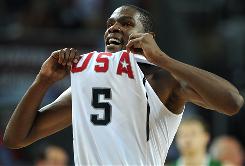Soft, Selfish, or Stupid
Last week in Boston the fifth annual MIT Sloan Sports Analytics Conference was held, and while sadly I was not in attendance, the excellent ESPN True Hoop blog provided an outstanding series of posts that offered summaries and commentary from the conference. Does he need more practice?
Does he need more practice?
One of the True Hoop posts reviewed a panel discussion titled 'Birth to Stardom, Developing the Modern Athlete in 10,000 Hours?'. This panel was moderated by 'Outliers' author Malcolm Galdwell, famous for his '10,000 hours' theory, (the time one needs to put it to achieve mastery at any given skill), and included (among others), Steve's HR Technology favorite basketball analyst, the great Jeff Van Gundy.
The discussion centered around the modern athlete and the debate surrounding the age-old question of nature vs. nurture. Do sports stars have innate, natural ability that assures success, or are they developed due to the combination of training, early identification, and almost obsessive focus on performance? In other words, does the '10,000 hours' theory apply at the highest levels of athletics?
While in athletics, the inherent physical characteristics that place most of the top performers at an advantage can't realistically be debated (if you are only 5' 3", putting in the 10,000 hours still likely won't land you in the NBA), what is open to discussion is the relative importance in athletic achievement of 'nurture', and the necessity of supremely physically talented athletes to diligently practice, refine, and improve their skills over time. As we know, many of the games greatest stars were not necessarily the hardest workers (see Iverson, Allen in 'Talkin' About Practice').
And certainly the access to and the involvement of mentoring and coaching play a role in athletic development as well; even the most dedicated pracitioner will need guidance along the path, and coaches have to be prepared to adapt their approaches to better fit the talents and goals of the athletes.
In the end, there seemed to be agreement (perhaps obvioulsly), that for most athletes, a combination of 'nature', (raw, physical traits and ability), combined with 'nurture' (work habits, dedication, ability to accept coaching), were necessary conditions for athletes to achieve their greatest potential. Sure, it could be argued whether the '10,000 hours' level is really relevant in athetics (often the length of time needed to put it 10,000 hours would result in a loss due to aging and injuries of some of the raw physical abilities needed to succeed), but the basic equation of Raw Talent + Hard Work = Success seems to hold.
But beyond the obvious conclusion, the great Jeff Van Gundy offered up this nugget of wisdom, observing that all players that arrive in the NBA have at least a baseline of physical ability, i.e. there are no slow, short, unathletic players, but the real differentiators were more intangible. According to JVG professional athletes need to balance the physical with the attitudinal.
JVG's money line: “Soft, selfish or stupid. You can be one of these things, but you can’t be two.”
Super point, and one that likely applies beyond sports as well. While we all have this idea in our minds when we are managing, leading, or recruiting for our organizations of what the 'perfect' or 'high potential' employee looks like, the reality is those 'perfect' employees and candidates are almost impossible to define and to find. But often we don't admit this, and we just keep grinding, keep sourcing to uncover that one person out there that isn't 'soft, selfish, or stupid', when in reality we could live with having two of the three characteristics, and manage around the one that is missing.
The greatest players certainly, win on all three variables, but the other 95% that make up our teams, (and almost all of us) will fall short of at least one of them. Maybe instead of holding on to a mostly unrealistic chase for a once-in-a-generation star, we build up a solid team of role players that can feed off each other, and perhaps make up for one another's shortcomings, (as well as yours).

 Steve
Steve
Reader Comments (2)
Good post Steve. I was an NBA guy for a long time, and believe the 2 out of 3 theory probably works for them. Now I'm a hardcore NHL guy and I don't think the theory holds up. Here's the rub...and a key point in your message: how do we integrate role players and leverage their strengths? Great question. Wish I had the perfect answer. In hockey we call that the "checking line."
@Jay - Great question. The role players in sports make a huge difference, in the NBA it is generally felt that to win a title you need one superstar, Top 50 all time type of player, then two other All Star caliber players alongside. But even that is no guarantee of winning, having 3 or 4 quality role players to fill out the roster can be the difference in winning or just competing. Hockey is a little different I think, but I bet it is still pretty hard to win the title without a couple of clear All Star talents on the team.